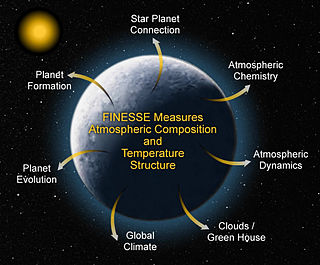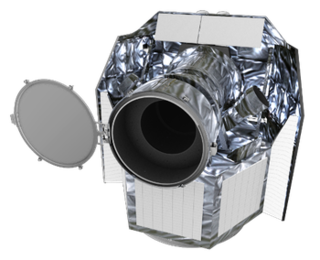Related Research Articles

The Laser Interferometer Space Antenna (LISA) is a proposed space probe to detect and accurately measure gravitational waves—tiny ripples in the fabric of space-time—from astronomical sources. LISA would be the first dedicated space-based gravitational wave detector. It aims to measure gravitational waves directly by using laser interferometry. The LISA concept has a constellation of three spacecraft arranged in an equilateral triangle with sides 2.5 million km long, flying along an Earth-like heliocentric orbit. The distance between the satellites is precisely monitored to detect a passing gravitational wave.
The Satellite Test of the Equivalence Principle (STEP) is a proposed space science experiment to test the equivalence principle of general relativity. The experiment is thought to be sensitive enough to test Einstein's theory of gravity and other theories.
Marco Polo was a proposed space mission concept studied between 2005 and 2015 that would return a sample of material to Earth from the surface of a Near Earth asteroid (NEA) for detailed study in laboratories. It was first proposed to the European Space Agency in collaboration with the Japan aerospace exploration agency JAXA. The concept was rejected four times between 2007 and 2015 for the Cosmic Vision programme "M" medium-class missions.

The Europa Jupiter System Mission – Laplace (EJSM-Laplace) was a proposed joint NASA/ESA uncrewed space mission slated to launch around 2020 for the in-depth exploration of Jupiter's moons with a focus on Europa, Ganymede and Jupiter's magnetosphere. The mission would have comprised at least two independent elements, NASA's Jupiter Europa Orbiter (JEO) and ESA's Jupiter Ganymede Orbiter (JGO), to perform coordinated studies of the Jovian system.
The Space Infrared Telescope for Cosmology and Astrophysics (SPICA), is a proposed infrared space telescope, follow-on to the successful Akari space observatory. It was a collaboration between European and Japanese scientists, which was selected in May 2018 by the European Space Agency (ESA) as a finalist for the next Medium class Mission 5 of the Cosmic Vision programme, to launch in 2032. The other 2 finalists are: THESEUS and EnVision. SPICA will improve on the spectral line sensitivity of previous missions, the Spitzer and Herschel space telescopes, between 30 and 230 µm by a factor of 50—100.

Colonel Luca Parmitano is an Italian astronaut in the European Astronaut Corps for the European Space Agency (ESA). He was selected as an ESA astronaut in May 2009. Parmitano is also a Colonel and test pilot for the Italian Air Force. Parmitano is the youngest non-Russian astronaut to undertake a long-duration mission, at 36 years and eight months old on the launch day of his mission.
Advanced Telescope for High-ENergy Astrophysics (ATHENA) is an X-ray observatory mission selected by ESA within its Cosmic Vision Program to address the Hot and Energetic Universe scientific theme. Athena will operate in the energy range of 0.2–12keV and will offer spectroscopic and imaging capabilities exceeding those of currently operating X-ray astronomy satellites – e.g. the Chandra X-ray Observatory and XMM-Newton – by at least one order of magnitude on several parameter spaces simultaneously.

PLAnetary Transits and Oscillations of stars (PLATO) is a space telescope under development by the European Space Agency for launch in 2026. The mission goals are to search for planetary transits across up to one million stars, and to discover and characterize rocky extrasolar planets around yellow dwarf stars, subgiant stars, and red dwarf stars. The emphasis of the mission is on earth-like planets in the habitable zone around sun-like stars where water can exist in liquid state. It is the third medium-class mission in ESA's Cosmic Vision programme and named after the influential Greek philosopher Plato, the founding figure of Western philosophy, science and mathematics. A secondary objective of the mission is to study stellar oscillations or seismic activity in stars to measure stellar masses and evolution and enabling the precise characterization of the planet host star, including its age.

Euclid is a visible to near-infrared space telescope currently under development by the European Space Agency (ESA) and the Euclid Consortium. The objective of the Euclid mission is to better understand dark energy and dark matter by accurately measuring the acceleration of the universe. To achieve this, the Korsch-type telescope will measure the shapes of galaxies at varying distances from Earth and investigate the relationship between distance and redshift. Dark energy is generally accepted as contributing to the increased acceleration of the expanding universe, so understanding this relationship will help to refine how physicists and astrophysicists understand it. Euclid's mission advances and complements ESA's Planck telescope. The mission is named after the ancient Greek mathematician Euclid of Alexandria.
The Large Observatory for X-ray Timing (LOFT) is a proposed ESA space mission originally slated to launch around 2022, and now proposed to launch around 2025. The mission will be devoted to the study of neutron stars, black holes and other compact objects by means of their very rapid X-ray variability. LOFT is supported by a large international collaboration, led by researchers spread over most of the European countries, including Italy, Switzerland, Germany, Denmark, United Kingdom, Greece, Ireland, the Netherlands, Poland, Czech Republic, Spain, and with contributions from Brazil, Canada, Israel, United States and Turkey. SRON Netherlands Institute for Space Research acts as principal investigator.
The Exoplanet Characterisation Observatory (EChO) was a proposed space telescope as part of the Cosmic Vision roadmap of the European Space Agency, and competed with four other missions for the M3 slot in the programme. On 19 February 2014 the PLATO mission was selected in place of the other candidates in the programme, including EChO.

The JUpiter ICy moons Explorer (JUICE) is an interplanetary spacecraft in development by the European Space Agency (ESA) with Airbus Defence and Space as the main contractor. The mission will study three of Jupiter's Galilean moons: Ganymede, Callisto, and Europa all of which are thought to have significant bodies of liquid water beneath their surfaces, making them potentially habitable environments.

Fast Infrared Exoplanet Spectroscopy Survey Explorer (FINESSE) was a NASA mission proposal for a space observatory operating in the Near-infrared spectrum for the Medium-Class Explorers program. The Principal Investigator was Mark Swain of the Jet Propulsion Laboratory in Pasadena, California.
Hayabusa Mk2 was a proposed Japan Aerospace Exploration Agency (JAXA) space mission aimed at visiting a small primitive asteroid and returning a sample to Earth for laboratory analysis. It was intended to be the follow-on mission to JAXA's Hayabusa mission, as well as the Hayabusa2 mission. The latest proposal for Hayabusa Mk2 stated its target to be the dormant comet 4015 Wilson–Harrington, with a launch of the probe in 2018. From 2007 to 2010, it was also considered as a joint JAXA-ESA mission under the name Marco Polo. The in-situ investigation and sample analysis would allow scientists to improve our knowledge of the physical and chemical properties of a small Near-Earth Object (NEO) which is thought to have kept the original composition of the solar nebula in which planet formed. Thus, it would provide some constraints to the models of planet formation and some information on how life may have been brought to Earth. Information on the physical structure will help defining efficient mitigation strategies against a potential threatening object.

CHEOPS is a European space telescope to determine the size of known extrasolar planets, which will allow the estimation of their mass, density, composition and their formation. Launched on 18 December 2019, it is the first Small-class mission in ESA's Cosmic Vision science programme.

The Atmospheric Remote-sensing Infrared Exoplanet Large-survey (ARIEL), is a space telescope planned for launch in 2029 as the fourth medium-class mission of the European Space Agency's Cosmic Vision programme. The mission is aimed at observing at least 1,000 known exoplanets using the transit method, studying and characterising the planets' chemical composition and thermal structures. Compared to James Webb Space Telescope, ARIEL will have more observing time available for planet characterisation but a much smaller telescope.
Transient High-Energy Sky and Early Universe Surveyor (THESEUS) is a space telescope mission proposal by the European Space Agency that would study gamma-ray bursts and X-rays for investigating the early universe. If developed, the mission would investigate star formation rates and metallicity evolution, as well as studying the sources and physics of reionization.

The Science Programme of the European Space Agency is a long-term programme of space science and space exploration missions. Managed by the agency's Directorate of Science, The programme funds the development, launch, and operation of missions led by European space agencies and institutions through generational campaigns. Horizon 2000, the programme's first campaign, facilitated the development of eight missions between 1985 and 1995 including four "cornerstone missions" – SOHO and Cluster II, XMM-Newton, Rosetta, and Herschel. Horizon 2000 Plus, the programme's second campaign, facilitated the development of Gaia, LISA Pathfinder, and BepiColombo between 1995 and 2005. The programme's current campaign since 2005, Cosmic Vision, has so far funded the development of ten missions including three flagship missions, JUICE, ATHENA, and LISA. The programme's upcoming fourth campaign, Voyage 2050, is currently being drafted. Collaboration with agencies and institutions outside of Europe occasionally occur in the Science Programme, including a collaboration with NASA on Cassini–Huygens and the CNSA on SMILE.
Cosmic Vision is the third campaign of space science and space exploration missions in the Science Programme of the European Space Agency (ESA). Formulated in 2005 as Cosmic Vision: Space Science for Europe 2015–2025, the campaign succeeded the Horizon 2000 Plus campaign and envisioned a number of missions in the fields of astronomy and solar system exploration beyond 2015. Ten missions across four funding categories are planned to be launched under Cosmic Vision, with the first being CHEOPS in December 2019. A mission to the Galilean moons, JUICE, the first deep space mission with an opportunistic target, Comet Interceptor, and one of the first gravitational-wave space observatories, LISA, are planned for launch as part of the Cosmic Vision campaign.
References
- ↑ STE-QUEST ESA summary
- ↑ "ESA selects planet-hunting PLATO mission". ESA. 19 February 2014. Retrieved 20 March 2014.
